Abstract
In 1944, the architect Antonio Gómez Davó designed and built a new house for Mr. Ferrer at Rocafort in the suburbs of Valencia (Spain). In this same year, Europe, America, Russia and even Japan were still at war and Spain was recovering from its own intestine conflict. Therefore, architectural innovations and influences were scarce, as was the circulation of specialized journals on the matter. Still, many creations were occurring, like ceramic vaults and the brise-soleil; further, the architect Le Corbusier had stated his profound nostalgia for the Mediterranean, a sea that he had come to appreciate in his travels to the “East”. In the case of Gómez Davó, having been born and raised in a prominent family of Valencia, he could not remain indifferent to the design features that appeared in the vernacular architecture of the area, especially the type of inclined louvers of Arabic descent, that covered bow-windows and balconies and which have come to be known in Spain as the Majorcan louvers; these are currently even employed by prominent architects like Rafael Moneo at the extension of the Painter Miro Foundation. However, with so many difficult circumstances surrounding him, Gómez Davó could not get to the point of producing a ground-breaking design based on solar assumptions for the whole façade of the house he was building; instead, when providing an entrance porch apt for living life in the pure Mediterranean tradition, he ventured to construct a surprising perforated wall oriented to the south in order to control radiation in the winter and provide shade in the summer while affording excellent light and superb conditions of ventilation. By means of self-devised simulation tools, we have analyzed the conditions of the house and especially of his innovative brise-soleil, which are at times reminiscent of Alvar Aalto’s solutions for day-lit roofs, and which he intuitively adapted to the latitude of Valencia with the help of incipient notions of solar geometry. By outlining such unknown and bold precedent and assessing the house’s proper climatic performance, we contribute to revitalizing the early and daring pioneers of solar architecture in peripheral Spain and Europe during the birth of critic regionalism, a fact often disregarded in the conventional history of Modern Architecture.
1. Introduction
Antonio Gómez Davó was an architect educated in the latter wake of Spanish regional modernism (reminiscent of Art Nouveau). With respect to his precedents, we could perhaps include architects such as Antoni Gaudi, Jujol [1] or the Seville-born Aníbal González. Each one of them resorted frequently to Asia as a source of inspiration, and especially the Mediterranean Levant, to an architectural idiom rich with features of the “arabesque” [2,3].
In this context of “oriental” architecture [4], the sunny weather of the “deserts” was a constant, and elements and features that could control the excess of solar radiation and provide some air movement were persistent [5]. One of the most important of them is usually represented by the “mashrabiya” مشربية, which derives from the Arabic verb شرب, normally meaning to “drink” [6], as the chamber in which it was placed soon became the coolest place of the house whence honored guests (Figure 1) were invited to take refreshments [7,8]. Another similar element is the well-known Indian “jali”, which incidentally in Arabic means sitting (room) [9].
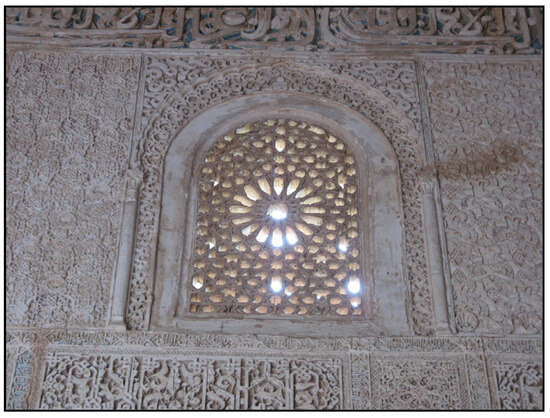
Figure 1.
A window with gypsum lattice-work in the style of mashrabiya. Source and image credits: the authors.
Both the mashrabiya and the jali had the necessary function of cooling the adjacent chambers by means of ventilation and evaporation (as they were connected to water conduits, basins or even, if the former were not available, ceramic jars) [10,11], but they also were tailored to protect from indiscreet gazes, and in this manner we arrive at the term jalousie, descending from the Indian term for lattice, “jalis” [8].
In the Mediterranean, whose coastal architecture has maintained a prevalence of Arabic elements, notably in Spain [12] but mostly in Malta and occasionally Southern Italy [13,14], not only the masharabiya (Figure 2) was enhanced; it also evolved to a special kind of louvers which even today are designed as “Majorcan” in Spain and “Persiannes” [15] (from Persia) in France’s Midi [16].
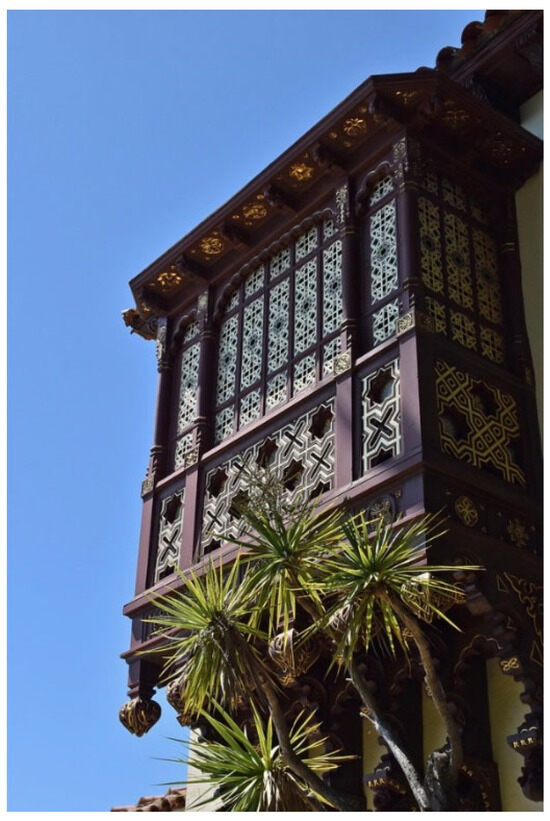
Figure 2.
A typical street mashrabiya. Source and image credit: the authors.
Among other distinguished architects, Le Corbusier, a self-confessed nostalgic of the Mediterranean [17] was well aware of such facts. Therefore, he developed the celebrated sun-breaker along with other Levantine features like the ceramic tile vault [18] that he had discovered from the Sagrada Familia school buildings (Figure 3) created by Gaudi [19]; the sun-controlling device also featured in one of his unbuilt dwelling projects for Barcelona.
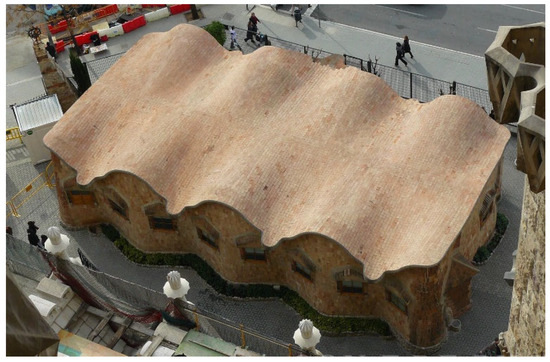
Figure 3.
The reconstructed Sagrada Familia Schools by A. Gaudi. Source and image credit: the authors.
With the novelty of the introduction of solar notions as related to building design, a new trend was inaugurated towards solar architecture. This started to develop independently in Brazil with the suggested ideas of Le Corbusier to the youngsters Oscar Niemeyer and Lucio Costa, and in Japan with the regards for nature and environment of Antonin Raymond, a former disciple of Wright, who was probably the first one to coin the term solar architecture [11]. Alvar Aalto also showed some early contributions to the issue from a Nordic perspective not exportable to other southerner latitudes [12]. Eventually the same Frank L. Wright came to produce solar buildings with this name for his creations in New Mexico and Arizona or where warm climates and deserts were part of the equation [14]. To be sure, Gomez Davó desired to echo all of the former. He was a modern architect who would not hesitate to build using concrete and steel [20], but at the same time, he was sensitive to the idiom of his native homeland of Valencia [21] and, naturally, he wanted to incorporate some shadow and cooling elements when possible, especially in the vicinity of windows and outdoor porches [22,23].
He had sought the opportunity in various projects, but always failed for one reason or another, until finally in this unassuming project for Mr. Ferrer, he was able to achieve one of his goals. We know from his first sketches [24] that he tried to create a perforated wall with circles (Figure 4, Figure 5, Figure 6, Figure 7 and Figure 8), much in the manner of Alvar Aalto in the Viipuri Library of 1929 but on a vertical plane [25]. It came to pass that the idea of the circles had to be discarded due to mounting costs and other drawbacks like the lack of space on the actual lot. In short, the original design was replaced by oblong octagons [26].
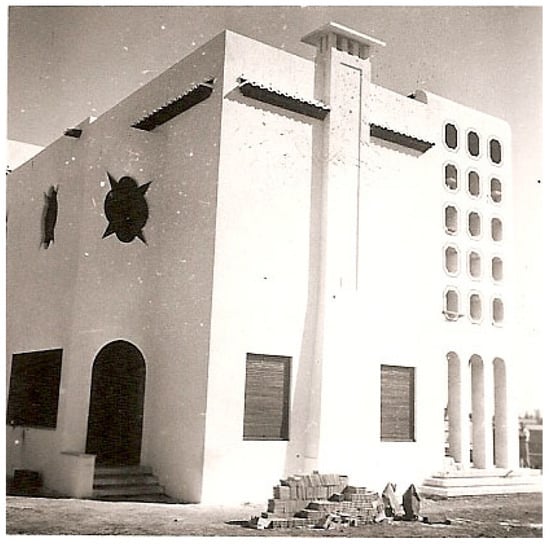
Figure 4.
View from the southwest of Ferrer’s house and the perforated wall. Source and image credits: archives of Gomez Gil.
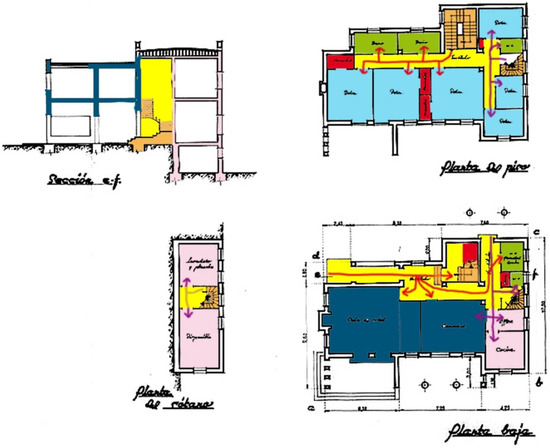
Figure 5.
Plans and sections of the Ferrer House. Source and image credits: archives of Gomez Gil.
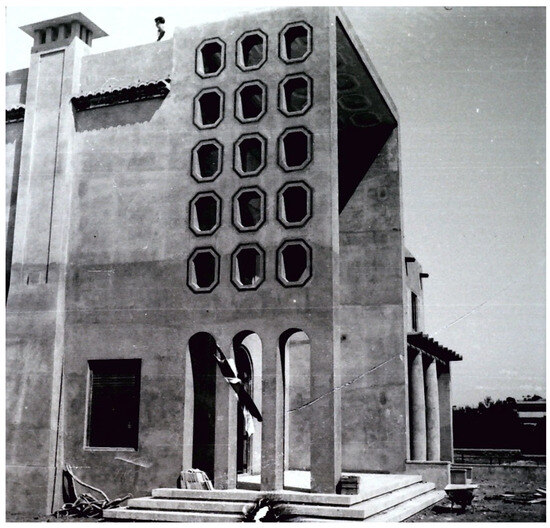
Figure 6.
View of the construction process of the Ferrer House. Source and image credits: archives of Gomez Gil.
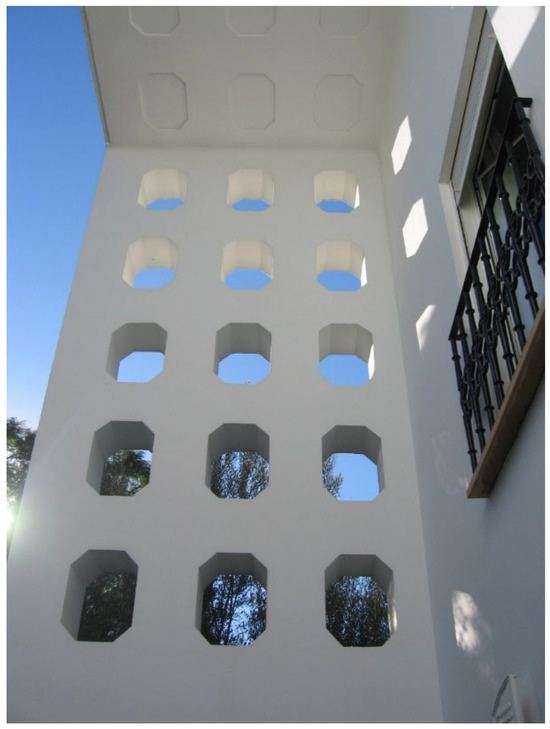
Figure 7.
Details of the porch at the Ferrer House. Source and image credit: the authors.
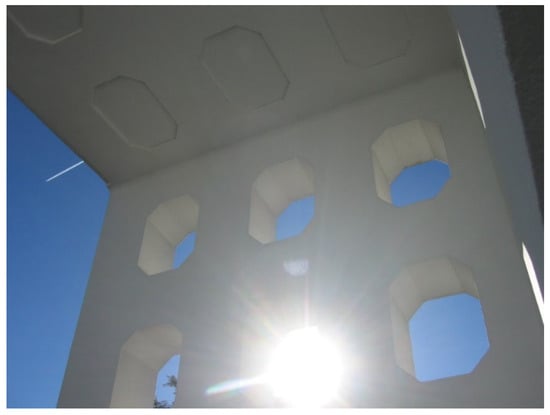
Figure 8.
The sun entering in winter through one of the openings. Source and image credit: the authors.
In the plans shown in Figure 5, we can see how he had to opt for a mainly eastern exposure of the detached house for better views and predominant breezes during the summer. However, he allowed for more freedom in the entrance porch.
He desired to protect this area from excessive radiation and unwanted winds which could disturb long hours spent outdoors (Figure 6, Figure 7 and Figure 8).
The design was optimized to obtain a better climatic performance. In other words, he sought ways to achieve the optimal diffusion of natural energies, such as sunlight, daylight, and wind [27]. The control of solar radiation both in winter and in summer is an important pre-requisite for the design of such types of residences but it was altogether uncommon in this period [28,29]. Very few projects, let alone a small number, pertaining to the Bauhaus sphere demonstrated concern for the relationship with the environment outside of the selection of the view [30]. Le Corbusier’s ideas had been generated in the mild climates of Central Europe and had little consideration for the problems of hot weather which were roughly considered marginal to the space of modernity [31], thus promoting the advent of the infamous International Style [29].
In the case of sunny climates, as in Eastern Spain, the use of glazed surfaces preconized by glass-box adepts needs to be reviewed in detail to reduce energy use, since they present significant repercussions for the cooling demand [32].
Moreover, outside the capitals of Madrid and Barcelona, the design of curtain walls and openly glazed facades has little or negligible repercussions [32].
2. Materials and Methods
The handicaps posed by direct sun over architectural structures are not adequately dealt with in conventional software like Grasshopper’s that only takes into account diffuse radiation [33]. A conscious understanding of solar geometry for the current designs is necessary, and with it, adequate tools to compute the paramount contribution of solar radiation gains to the spaces and comfort of people; we have devised such tools in this study [34].
In order to establish the performance of the solar porch under consideration, we started by studying the solar movements and the incidence of radiation around the location of the house with the help of a piece of personally developed software (Diana X).
This program determines the radiative field produced by any radiation-emitting three-dimensional shape over the surrounding space and it is mainly based on the solution of the canonical equation (Figure 9) or the reciprocity theorem for any possible form (Equation (1)) [9]:
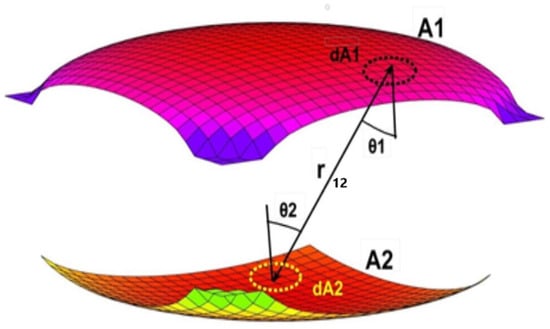
Figure 9.
Radiative emissions for a couple of surfaces of any type, A1 and A2. Source and image credits: Joseph Cabeza-Lainez.
As explained in [34], Equation (1) describes the respective quantity of radiative energy by unit area that will impinge on any of the two surfaces concerned, E1 and E2. The corresponding incident angles θ1 and θ2, which are depicted in Figure 9, represent the tilt to the normal of the distance line that connects two arbitrary points belonging to each surface named r12, as in both Equation (1) and Figure 9 [35].
In order to solve Equation (1), we need find out the inner part of the integral, as expressed in Equation (2) [36].
Once this is performed, the remaining task reduces to applying Equation (2) to the particular shapes of the octagon, instead of an indeterminate surface like in Figure 9; as mentioned, these figures are found in the lateral wall of the porch (Figure 10).
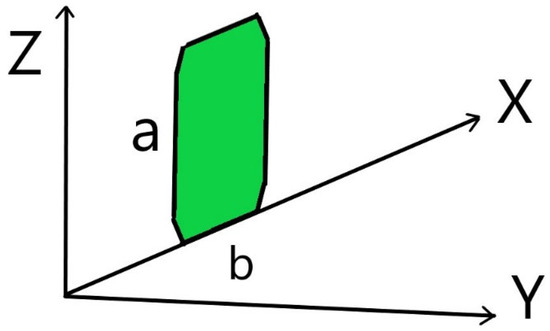
Figure 10.
Coordinates of the octagon used for calculations with main sides a and b. Source: Joseph Cabeza-Lainez.
Secondly, to initiate the analysis, we present the solar charts for the precise location which formed the basis for further proceeding with the radiation study (Figure 11 and Figure 12).
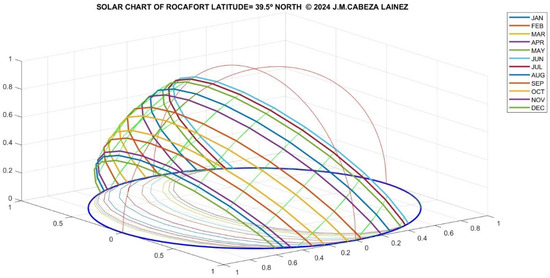
Figure 11.
Solar chart for Rocafort where the Ferrer House is located. Software by the author.
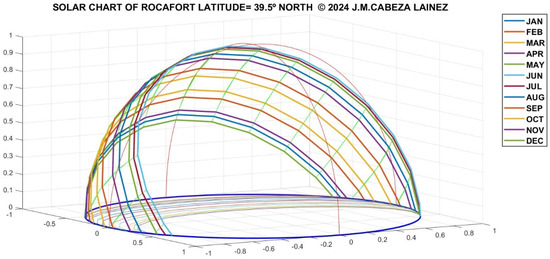
Figure 12.
Solar chart for Rocafort. View from the northeast. Drawing output from the software by Joseph Cabeza-Lainez.
Unlike other software, ours deals with radiant or illuminated surfaces and it is not based on sky models; therefore, our approach to situations of direct sun radiation is more straightforward and especially suited for cases like this.
We have to stress that in the solar geometry manual of Gómez Davó, the latitude of Valencia is set at 38 deg. north, one degree below the real latitude of the area, but we do not believe that this minor slight produced a considerable error in the construction details of the porch, because such was the tolerance of the construction of walls in Spain.
By analyzing the charts we created with our Diana X software in depth, it is clear that in these latitudes, the solar height in the winter is around 40 degrees, thus facilitating the penetration of the sun by any vertical aperture oriented to the south [37]. However, around the summer solstice, this altitude is around 70 degrees and the incidence of the sun is scarce. That is the main interest of porches with a Southern exposure, which the architect used advantageously. The octagonal openings on the perforated wall were carefully dimensioned to permit the passing of the sun and the wind while at the same time maintaining adequate strength as a bearing structure [38].
We checked with the help of the above solar charts (Figure 13 and Figure 14) that we constructed, comparing with a satellite three-dimensional image (Figure 15) and a scale-model (Figure 16), that overshadowing does not appear at virtually any moment of the year.
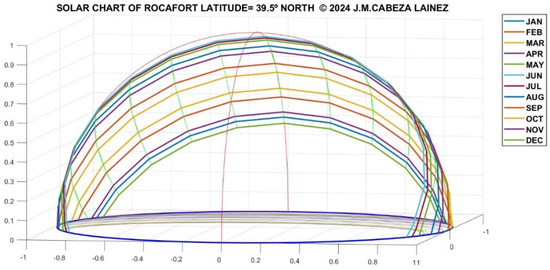
Figure 13.
Solar chart from the southeast. Source and image credits: Joseph Cabeza-Lainez.
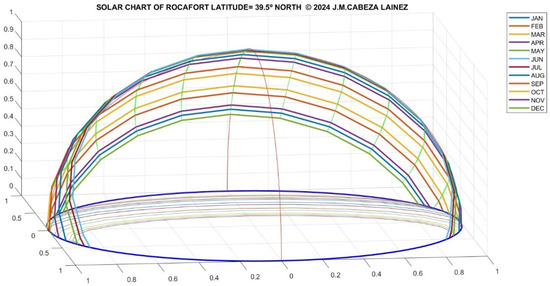
Figure 14.
View of the solar movement from the southeast. Source and image credits: Joseph Cabeza-Lainez.
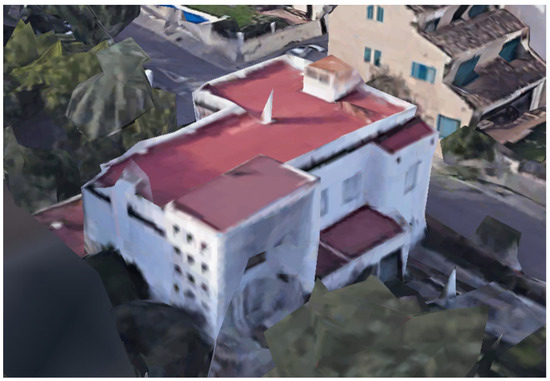
Figure 15.
The current 3D satellite image of the house. Source and image credits: Joseph Cabeza-Lainez.
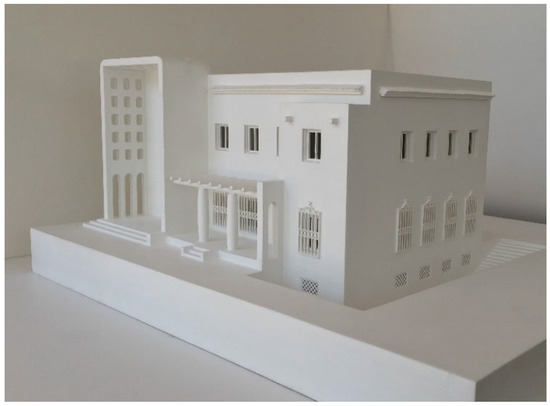
Figure 16.
Three-dimensional calculation model. Source and image credits: the authors.
Surely, this is a necessary aspect to check in the winter. On the contrary, during the summer period, less radiation is desirable but we still need to maintain acceptable daylight levels and adequate ventilation [39].
The complete results of the solar performance are given in Figure 17 for the dates of 1 January, 4 April, 7 July and 10 October, approximately corresponding with the solstices and the equinoxes.
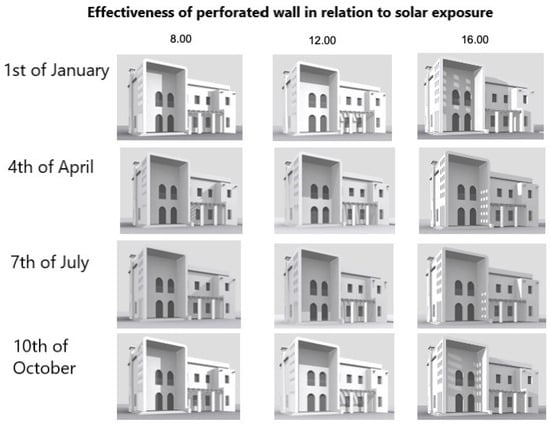
Figure 17.
Evolution of sunbathed and shaded areas, at different hours throughout the year. Source and image credits: the authors.
Different hours of the day were considered to obtain a more general idea of the overall performance of the sun-porch.
This solar performance in itself justifies the design employed, but it is also necessary to check the design under radiation premises, as we will do in the following section [38].
3. Results of the Simulation
We show below some of the most relevant computer results of the simulations (Figure 18, Figure 19, Figure 20 and Figure 21). We needed to trace the extent of the solar patches that appear on the façades and on the floor of the porch.
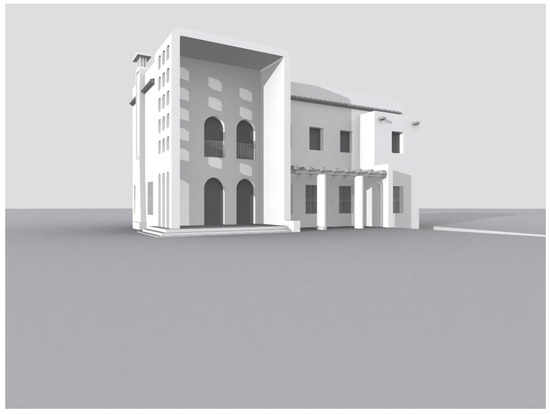
Figure 18.
The sun-patches that appear on the wall of the porch on the morning of 1 January. Source and image credits: the authors.
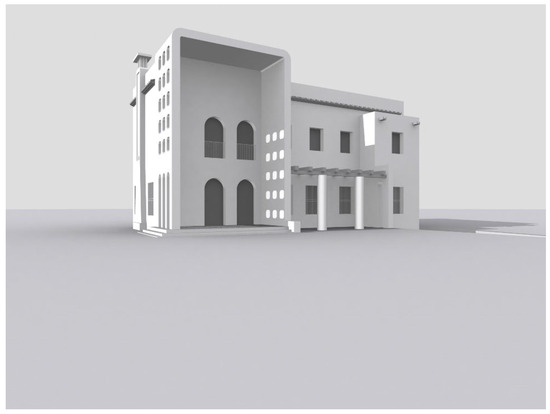
Figure 19.
Solar movement under the porch on 4 April at midday. Source and image credits: the authors.
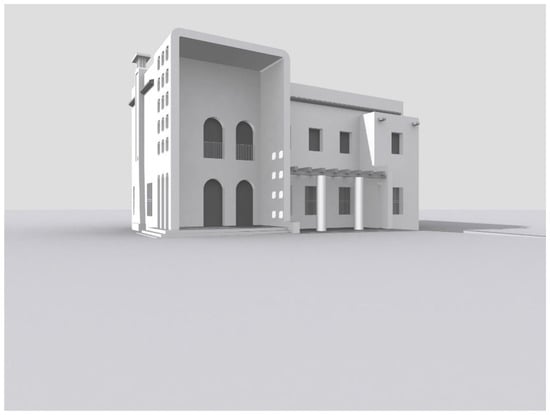
Figure 20.
Simulation graph for noon on 7 July. Source and image credits: the authors.
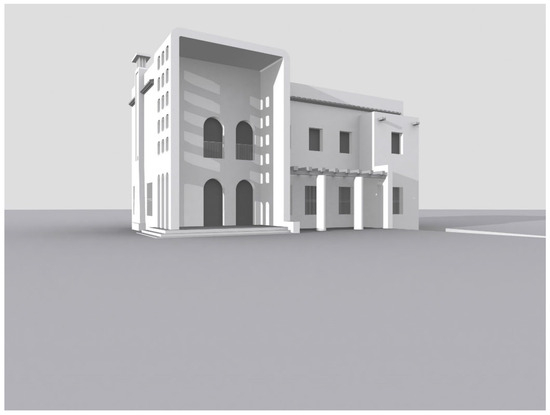
Figure 21.
The same graph for around noon on 10 October. Source and image credits: the authors.
We have demonstrated with these simulations that the areas swept by the sun tend to be lower in height or are directly on the floor as the year advances to the summer solstice; at this moment, the area illuminated by direct radiation is almost negligible [40].
Based on the former observations, we have concluded that the design of the solar porch is optimal from the point of view of shading in the summer and illuminating in the winter [41].
4. Discussion
It is necessary now to check alternatives from the point of view of radiation, employing Equations (1) and (2) in the simulation software and having in mind the graph in Figure 10 [39].
The type of equation that we used for the simulation is Equation (3) [8]; see this equation below, with the corresponding amounts determined by the dimensions of the octagon a and b and the dimensions of the porch [41,42].
The former are just geometric parameters related to the configuration of the design solution. Subsequently, we had to introduce the radiation data available for Valencia about the direct and the diffuse radiation so that we could use them in the simulation rounds (Figure 22, Figure 23 and Figure 24). In the output of the software, the general calculations appear in Kwh/m2, while the detailed output for winter and summer for the sole porch zone appear in W/m2 [43].
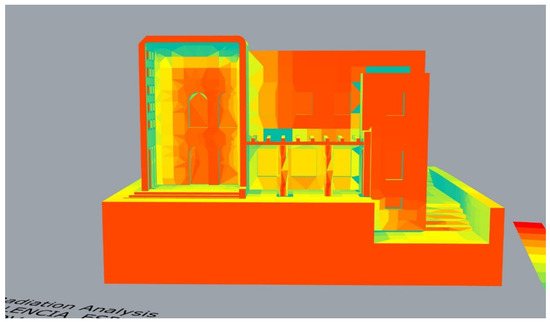
Figure 22.
General thermograph and radiation analysis of the house in the summer. Source and image credits: the authors.
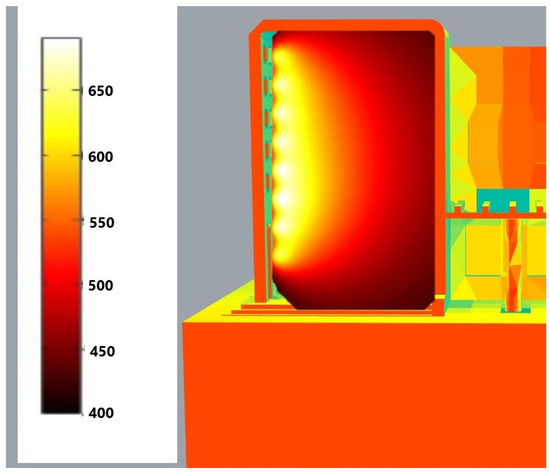
Figure 23.
Detail of radiation distribution in the winter in W/m2. Source and image credits: Joseph Cabeza-Lainez.
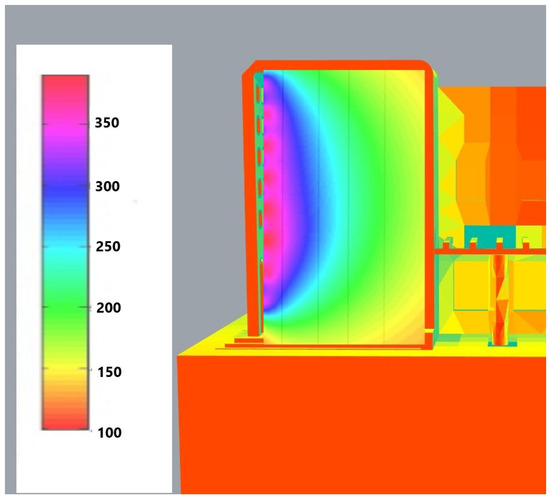
Figure 24.
Detail of radiation distribution in summer in W/m2. Source and image credits: Joseph Cabeza-Lainez.
Looking closely at Figure 23, we can observe that the values in the winter range from 600 to 400 W/m2, which is an excellent value for this latitude by all standards [37]. In the summer, as shown in Figure 24, the values are generally reduced between a maximum of 300 W/m2 and 100. This reveals that the porch is not uncomfortable in the months of June and July by the effects of radiation alone while daylighting is kept at a satisfactory level. The probability of a cloudy sky is 5% in the summer and maybe around 15% in the winter [39]; therefore, the winter values should be balanced with caution as they do not have a 100% occurrence.
Finally, for the general analysis of radiation in Figure 25 and Figure 26, we note the mild values achieved in the winter from 350 to 100 Kwh/m2 and slightly more elevated quantities for the case of summer when the intensities of direct radiation were much higher. This seems like a good index of the level of protection from excessive radiation that the designed elements are able to attain [35].
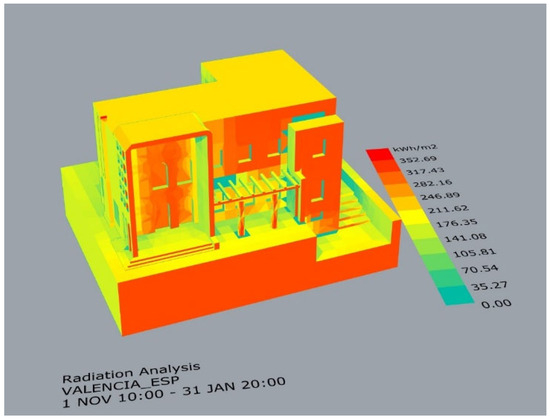
Figure 25.
Thermograph of the building in the winter. Source and image credits: the authors.

Figure 26.
Thermograph of the building in the summer. Source and image credits: the authors.
Further developments and knowledge are expected to be achieved when we apply CFD analysis with fluent and other specific software to the wind flow around the urban area to discover the contribution of breezes from the sea to the overall comfort of the outdoor spaces [41,44] and especially of the porch area [45]. Also, specific comfort studies need to be implemented like determining the PMV or Predicted Mean Vote from users.
5. Conclusions
The design solutions adopted at the Ferrer House in Valencia constitute an important precedent that we consider to have inaugurated a trend towards critical regionalism in the area and especially in the dedicated production of the architect Gómez Davó. The radiation and solar performance of the building and especially of the entrance porch have been evaluated and assessed with state-of-the-art tools that we developed specifically for this research. Also, we took advantage of our own software, which uses radiative surfaces directly instead of basing itself on unreliable or unpredictable sky models.
It is regrettable that with the end of the Pacific War, and the imposition of restrictions on the debilitated Spanish economy under Francoism, Gómez Davó was forced to discontinue this kind of solution in favor of a much more restricted type of architecture, to say the least. Architecture itself was turning into a sort of emblem for the regime of the era. But still we are left with this important example of an insight that could have been influential for many in the Spanish east.
Prominent architects of the era envisioned the design of the brise-soleil as a potential solution to (though not to say salvation from) the excesses of radiation in hot climates, but they were seldom capable of realizing such designs for several reasons. Some isolated examples came to appear in India and Brazil. Nevertheless, lacking the technical tools of analysis and the required expertise, the results were controversial and misleading, and as such were often criticized. On the contrary, the porch of the Ferrer House can be considered successful even by modern standards.
Regarding further advances of this research, we would like to add the wind flow performance of different elements that appear in this house. Another pending issue is to study the comfort conditions in and around the house. One limitation of this study is that, due to current financial problems at the house, it is difficult to apply direct monitoring on the premises.
Generally speaking, we believe that we have demonstrated to a considerable extent that the design applied by Gómez Davó exceeds the performance of other sun-breakers proposed by his contemporaries. We measured this performance in relation to the aspects of lighting and protection from solar radiation. In the near future, we intend to launch a new analysis campaign in order to establish the levels of comfort obtained in the Ferrer House.
Author Contributions
Conceptualization, A.G.-G.; methodology, J.C.-L.; software, J.C.-L.; validation, J.C.-L.; investigation, J.C.-L.; resources, A.G.-G.; data curation, J.C.-L.; writing—draft. A.G.-G.; writing—original, J.C.-L. All authors have read and agreed to the published version of the manuscript.
Funding
This research received no external funding.
Data Availability Statement
The original contributions presented in the study are included in the article, further inquiries can be directed to the corresponding author.
Acknowledgments
Antonio Gómez Gil dedicates this article to Teresa for her patience and kindness. Joseph Cabeza-Lainez would like to thank the courtesy of the Gómez Gil archives. We would like to remember the figure of Jose Maria Cabeza Arroyo, who introduced the authors to the realm of building techniques.
Conflicts of Interest
The authors declare no conflict of interest.
References
- Belakehal, A.; Tabet, K.; Bennadji, A. Sunlighting and daylighting strategies in the traditional urban spaces and buildings of the hot arid regions. Renew. Energy 2004, 29, 687–702. [Google Scholar] [CrossRef][Green Version]
- Lara, F.; Kim, Y. Built global, lived local: A study of how two diametrically opposed cultures reacted to similar modern housing solutions. J. Archit. Plan. Res. 2010, 27, 91–106. Available online: https://www.jstor.org/stable/43030898 (accessed on 29 July 2023).
- Ghisi, E.; Tinker, J.A. An ideal window area concept for energy efficient integration of daylight and artificial light in buildings. Build. Environ. 2005, 40, 51–61. [Google Scholar] [CrossRef]
- Cabeza-Lainez, J. Architectural Characteristics of Different Configurations Based on New Geometric Determinations for the Conoid. Buildings 2022, 12, 10. [Google Scholar] [CrossRef]
- Heschong, L. Thermal Delight in Architecture; MIT Press: Cambridge, MA, USA, 1979; ISBN 026258039X. [Google Scholar]
- Nocera, F.; Lo Faro, A.; Costanzo, V.; Raciti, C. Daylight Performance of Classrooms in a Mediterranean School Heritage Building. Sustainability 2018, 10, 3705. [Google Scholar] [CrossRef]
- Holman, J.P. Heat Transfer, 7th ed.; Mac Graw Hill: New York, NY, USA, 1995. [Google Scholar]
- Moon, P.H.; Spencer, D.E. The Photic Field; The MIT Press: Cambridge, MA, USA, 1981. [Google Scholar]
- Siret, D. L’illusion du brise-soleil par Le Corbusier. In Colloque Langages Scientifiques et Pensée Critique: Modélisation, Environnement, Décision Publique; ffhalshs-00580040f; Belin Editions: Cerisy, France, 2002. [Google Scholar]
- Subramaniam, S.; Hoffmann, S.; Thyageswaran, S.; Ward, G. Calculation of View Factors for Building Simulations with an Open-Source Raytracing Tool. Appl. Sci. 2022, 12, 2768. [Google Scholar] [CrossRef]
- Modest, M.F. View Factors. In Radiative Heat Transfer, 3rd ed.; Academic Press: Cambridge, MA, USA, 2013. [Google Scholar]
- Hensen, J.L.M.; Lamberts, R. Building Performance Simulation for Design and Operation, 2nd ed.; Routledge: London, UK, 2019; ISBN 9781138392199. [Google Scholar]
- Howell, J.R.; Siegel, R.; Mengüç, M.P. Thermal Radiation Heat Transfer, 5th ed.; Taylor and Francis/CRC: New York, NY, USA, 2010. [Google Scholar]
- Moon, P.H. The Scientific Basis of Illuminating Engineering; McGraw-Hill Book Co. Dover Publications: New York, NY, USA, 1963. [Google Scholar]
- Feingold, A. Radiant-Interchange configuration factors between various selected plane surface. Proc. R. Soc. Lond. Ser. A Math. Phys. Sci. 1966, 292, 51–60. Available online: https://www.jstor.org/stable/2415616 (accessed on 2 July 2022).
- Lambert, J.H. Photometria. sive de Mensura et Gradibus Luminis, Colorum et Umbrae; DiLaura, D., Ed.; IESNA: New York, NY, USA, 2001; p. 1764. [Google Scholar]
- Hilbert, D.; Cohn-Vossen, S. Geometry and the Imagination; AMS (American Mathematical Society) Chelsea Publishing: Providence, RI, USA, 1990. [Google Scholar]
- Camaraza-Medina, Y.; Hernandez-Guerrero, A.; Luviano-Ortiz, J.L. View factor for radiative heat transfer calculations between triangular geometries with common edge. J. Therm. Anal. Calorim. 2023, 148, 4523–4539. [Google Scholar] [CrossRef]
- Fock, V. Zur Berechnung der Beleuchtungsstärke; Optisches Institut: St. Petersburg, Russia, 1924. [Google Scholar]
- Cabeza-Lainez, J. Innovative Tool to Determine Radiative Heat Transfer Inside Spherical Segments. Appl. Sci. 2023, 13, 8251. [Google Scholar] [CrossRef]
- Sasaki, K. View factor of a spheroid and an ellipse from a plate element. J. Quant. Spectrosc. Radiat. Transf. 2024, 326, 109102, ISSN 0022-4073. [Google Scholar] [CrossRef]
- Cabeza-Lainez, J. Finding the Exact Radiative Field of Triangular Sources: Application for More Effective Shading Devices and Windows. Appl. Sci. 2023, 13, 11318. [Google Scholar] [CrossRef]
- Schröder, P.; Hanrahan, P. On the Form Factor between Two Polygons. In Proceedings of the SIGGRAPH ’93: Proceedings of the 20th Annual Conference on Computer Graphics and Interactive Techniques, Anaheim, CA, USA, 2–6 August 1993; pp. 163–164. [Google Scholar] [CrossRef]
- Song, Y.; Zhang, T.; Qi, F. A correction method for calculating sky view factor in urban canyons using fisheye images. Build. Environ. 2024, 262, 111834, ISSN 0360-1323. [Google Scholar] [CrossRef]
- Howell, J.R. A Catalogue of Radiation Heat Transfer Configuration Factors. University of Texas at Austin. Available online: http://www.thermalradiation.net/indexCat.html (accessed on 3 February 2021).
- Howell, J.R. A Catalogue of Radiation Heat Transfer Configuration Factors. Factor C-43b. Available online: http://www.thermalradiation.net/sectionc/C-43b.html (accessed on 22 March 2023).
- Howell, J.R. A Catalogue, Factor C-140b. Available online: http://www.thermalradiation.net/sectionc/C-140b.html (accessed on 23 February 2023).
- Howell, J.R.; Siegel, R.; Pinar, M.M. Radiative transfer configuration factor catalogue: A listing of relations for common geometries. J. Quanti. Spectrosc. Radiat. Transf. 2011, 112, 910–912. [Google Scholar] [CrossRef]
- Cabeza-Lainez, J.; Almodóvar-Melendo, J.-M.; Revenga-Dominguez, P.; Rodríguez-Cunill, I.; Xu, Y. New Simulation Tool for Architectural Design in the Realm of Solar Radiative Transfer. Designs 2022, 6, 72. [Google Scholar] [CrossRef]
- Milton, R. The Ungreen Brise-soleil. Hidden Archit. J. 1936, 1, 17. Available online: https://hiddenarchitecture.net/ungreen-brise-soleil/ (accessed on 7 September 2020).
- Camaraza-Medina, Y. Polynomial cross-roots application for the exchange of radiant energy between two triangular geometries. Ingenius Rev. Cienc. Y Tecnol. 2023, 30, 29–41. [Google Scholar] [CrossRef]
- Feingold, A. A new look at radiation configuration factors between disks. J. Heat Transf. 1978, 100, 742–744. [Google Scholar] [CrossRef]
- Acosta, W. Vivienda y Clima; Ediciones Nueva Visión: Buenos Aires, Argentina, 1976. [Google Scholar]
- Gershun. The Light Field (translated from Russian by P. Moon and G. Timoshenko). J. Math. Phys. 1939, 18, 17. [Google Scholar]
- Cabeza-Lainez, J. A New Principle for Building Simulation of Radiative Heat Transfer in the Presence of Spherical Surfaces. Buildings 2023, 13, 1447. [Google Scholar] [CrossRef]
- Naraghi, M.H.N. Radiative View Factors from Spherical Segments to Planar Surfaces. J. Thermophys. Heat Transf. 1988, 2, 373–375. [Google Scholar] [CrossRef]
- Chung, B.T.F.; Naraghi, M.H.N. Some Exact Solutions for Radiation View Factors from Spheres. AIAA J. 1981, 19, 1077–1108. [Google Scholar] [CrossRef]
- Sasaki, K.; Sznajder, M. Analytical view factor solutions of a spherical cap from an infinitesimal surface. Int. J. Heat Mass Transf. 2020, 163, 120477. [Google Scholar] [CrossRef]
- McAdam, D.W.; Khatry, A.K.; Iqbal, M. Configuration Factors for Greenhouses. Am. Soc. Ag. Eng. 1971, 14, 1068–1092. [Google Scholar]
- Mathiak, F.U. Berechnung von konfigurationsfactoren polygonal berandeter ebener gebiete (Calculation of form-factors for plane areas with polygonal boundaries). Warme-Und Stoff Bertragung 1985, 19, 273–278. [Google Scholar] [CrossRef]
- Minning, C.P. Calculation of shape factors between parallel ring sectors sharing a common centerline. AIAA J. 1976, 14, 813–815. [Google Scholar] [CrossRef]
- Dunkle, R.V. Configuration factors for radiant heat-transfer calculations involving people. J. Heat Transf. 1963, 85, 71–76. [Google Scholar] [CrossRef]
- Nußelt, W. Graphische Bestimmung des Winkelverhältnisses bei der Wärmestrahlung. Z. Ver. Dtsch. Ing. 1928, 72, 673. [Google Scholar]
- Naraghi, M.H.N. Radiation View Factors from Differential plane sources to disks- A general formulation. Tech. Notes Am. Inst. Aeronaut. Astronaut. J. 1988, 2, 3. [Google Scholar] [CrossRef]
- MacAllister, A.S. Graphical solutions of problems involving plane surface lighting sources. Light. World 1911, 56, 135. [Google Scholar]
Disclaimer/Publisher’s Note: The statements, opinions and data contained in all publications are solely those of the individual author(s) and contributor(s) and not of MDPI and/or the editor(s). MDPI and/or the editor(s) disclaim responsibility for any injury to people or property resulting from any ideas, methods, instructions or products referred to in the content. |
© 2024 by the authors. Licensee MDPI, Basel, Switzerland. This article is an open access article distributed under the terms and conditions of the Creative Commons Attribution (CC BY) license (https://creativecommons.org/licenses/by/4.0/).